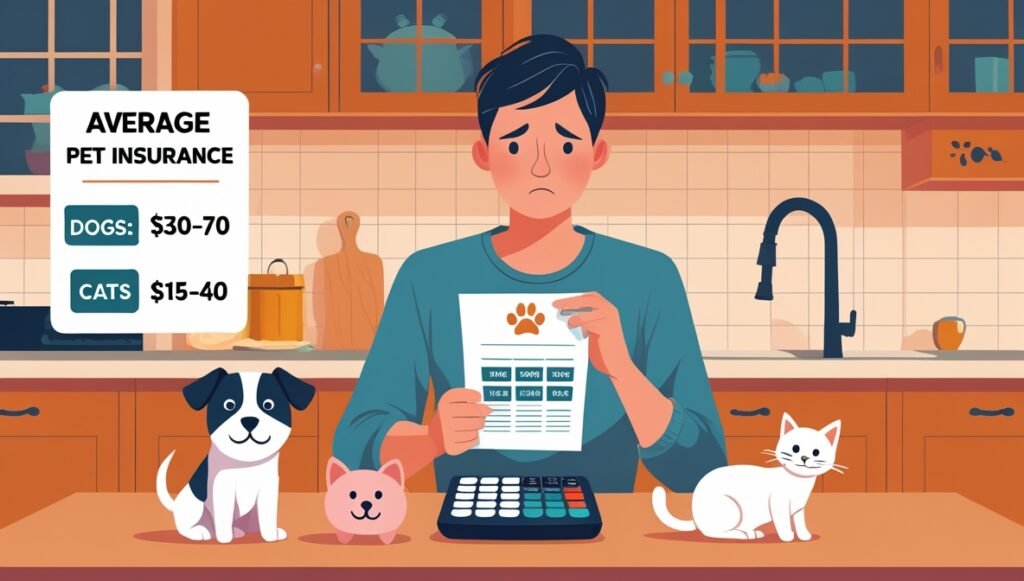Let’s rewind to a chilly fall day a few years back. I’m at the park with my scruffy little terrier, Jasper, bundled up in a scarf while he’s darting through piles of leaves like they’ve personally offended him. He’s in full zoomie mode when—oops—he trips over a gnarly tree root and lets out a pitiful yelp. My heart sinks as I scoop him up, and before I know it, we’re at the vet. The damage? A $1,400 bill for X-rays and a splint. I had pet insurance, thank goodness, but as I sat there, cradling Jasper and sipping the vet’s terrible coffee, I couldn’t help but wonder: What am I really paying for this safety net—and is it worth every penny?
If you’re thinking about pet insurance for your dog or cat, I bet you’re wondering the same thing—how much is this going to cost me? What makes the price go up or down? And how do I make sure I’m not overpaying for something that’ll keep my furry bestie safe? Let’s sit down together and figure this out, with a few tales from my pet-parent adventures to guide us. By the time we’re done, you’ll know exactly what to budget for your own Jasper, Luna, or whoever’s stealing your heart (and maybe your socks).
Let’s Start with the Basics: What’s This Gonna Cost Me?
Pet insurance isn’t a one-time splurge—it’s more like your Netflix subscription, a little monthly fee with some extras to keep in mind. To get the full picture, you’ve got to know the three main pieces: premiums, deductibles, and reimbursement rates. Let me break it down with a sprinkle of my own experience.
- Premiums: This is the monthly bill you’ll see—it’s the starting point. For dogs, you’re looking at $30 to $70 a month, and for cats, it’s usually $15 to $40. Jasper’s my three-year-old terrier, and I pay $45 a month for a plan that covers accidents and illnesses. My sister’s cat, Luna, a seven-year-old tabby who’d rather nap than chase her tail, costs her $25 a month. It’s the first number to wrap your head around, but there’s more to it.
- Deductibles: This is what you pay out of your own pocket before the insurance folks step in. It might be a yearly thing or per vet visit—$100 to $500 is pretty typical. I went with a $200 annual deductible for Jasper, so I cover the first $200 of vet bills each year, and then they jump in. Want a lower deductible? Your monthly fee might creep up a bit.
- Reimbursement Rates: This is how much you get back after you’ve paid that deductible—usually 70%, 80%, or 90%. Jasper’s $1,400 vet bill from that park mishap? With my $200 deductible and 80% reimbursement, I paid $200 upfront, they covered $960, and I was left with $240 to handle. Not too bad, right?
Here’s how it played out for me: That $1,400 bill hit hard, but my insurance turned it into a much softer blow. Without it, I’d have been raiding my savings—or worse, my cookie jar. Knowing these three pieces—premiums, deductibles, and reimbursement—helps you see what you’re really signing up for.
What Makes the Price Go Up or Down?
The cost of pet insurance isn’t a fixed number—it wiggles around based on a few things about your pet and the choices you make. Let’s chat about what can nudge that price tag higher or lower, so you can plan ahead.
- How Old Your Pet Is: Puppies and kittens are cheaper to insure—less likely to have health drama. When Jasper was a tiny pup, I paid $35 a month; now that he’s three, it’s $45. Luna, at seven, costs more than a kitten would—older pets might run you $80 or more since they’re more likely to need a vet.
- Their Breed and Health Quirks: Some breeds come with a higher price tag. A bulldog with breathing issues or a Siamese cat prone to heart stuff will cost more than a scrappy mixed-breed like Jasper. My friend’s purebred retriever, Max, sets her back $65 a month because of his breed’s joint risks, while Jasper’s terrier mix keeps things more affordable.
- Where You Call Home: Vet bills—and insurance costs—depend on your zip code. I live in a mid-sized city, so Jasper’s plan is pretty average. In a big city like Chicago or San Francisco, you might pay 10-20% more—think $50 for a cat, $80 for a dog. Out in the country? You might catch a break.
- How Much Coverage You Want: More coverage means a bigger bill. An accident-only plan for Luna might be $15 a month, but if you want the full deal—accidents, illnesses, and wellness stuff like shots—it could hit $40. I picked a middle-of-the-road plan for Jasper, skipping the wellness extras to keep my monthly cost down.
- The Choices You Make: You’ve got some control here. I could drop Jasper’s premium to $30 if I picked a $500 deductible, but I’d be on the hook for more if he gets hurt. A 90% reimbursement rate sounds dreamy, but it’ll bump up your monthly fee.
My neighbor Jen found this out the hard way. Her beagle, Daisy, had a super cheap $20-a-month plan—until Daisy needed $2,500 surgery for a chewed-up toy. With a high deductible and low reimbursement, Jen still owed $900. She told me, “I should’ve paid a little more each month—it would’ve saved me a lot of stress.”
What’s the Average Cost? Let’s Talk Numbers
Alright, let’s get to the good stuff—what can you expect to pay for pet insurance for dogs and cats in the U.S.? These are ballpark numbers to give you a starting point, but your pet’s quirks will tweak them a bit.
- Dogs: A basic accident-and-illness plan for a young, healthy pup usually runs $30 to $50 a month. A mid-range plan like Jasper’s might be $40 to $60. Older dogs or fancy breeds with health risks? You could be looking at $70 to $100. Toss in wellness coverage—like for shots or flea meds—and add $10 to $20 more.
- Cats: Cats are generally easier on the wallet—$15 to $30 for a basic plan. Luna’s mid-range plan costs $25 a month. If your cat’s older or a purebred, you might hit $40 to $50 with wellness extras.
Here’s a little story: My cousin’s poodle, Tinker, is five and a total sweetheart. Her accident-and-illness plan costs $38 a month with a $250 deductible and 80% reimbursement. When Tinker swallowed a squeaky toy and needed $1,800 surgery, my cousin only paid $490 after insurance. She said it felt like a weight off her shoulders.

Sneaky Costs You Might Not See Coming
Pet insurance isn’t just about that monthly bill—there are a few hidden bits that can sneak up on you. I’ve been there, and I don’t want you to get caught off guard, so let’s shine a light on them.
- Sign-Up Fees: Some companies hit you with a one-time fee to get started—$10 to $50. I paid $25 to enroll Jasper, which felt like a little jab, but it was a one-time thing.
- Waiting Periods: You might be paying premiums but can’t use the coverage right away. Most plans make you wait 2-14 days for accidents and 14-30 days for illnesses. If Luna gets sick a week after you sign up, you’re on your own for that bill.
- Out-of-Pocket Bits: Even with insurance, you’re covering the deductible and whatever’s not reimbursed. Jasper’s $1,400 bill still left me with $440 to pay after all was said and done.
- Price Hikes: Premiums can creep up as your pet gets older or if you file claims. Jasper’s plan jumped $10 this year—I grumbled, but I still think it’s worth it.
My friend Sam still groans about his pup, Pickles, who needed a $600 ear infection fix during the waiting period. He’d paid premiums for two months but got nothing back. Moral of the story? Read the fine print—it’s your best buddy.
So, Is It Worth It?
Here’s the big question: Is pet insurance worth the cost? For me, it’s a no-brainer. Jasper’s $45 a month feels like pocket change compared to that $1,400 vet bill—or the $3,000 surgery my coworker’s husky, Sky, needed after eating a sock. Her $55-a-month plan turned that into a $650 out-of-pocket hit. Without it, she’d have been in tears.
But it’s not for everyone. If your cat’s a low-drama indoor kitty like Luna, and you’ve got a nice savings cushion, you might not need it. Think about your pet’s risks, your budget, and how much you’d stress without a safety net. For me, knowing Jasper’s got backup means I can enjoy our park days without worrying about the “what ifs.”
Let’s Wrap This Up
Pet insurance costs for your dog or cat don’t have to feel like a mystery. We’ve chatted about the basics—premiums, deductibles, reimbursement—and what makes the price wiggle, from age to coverage. You’ve got averages to work with and sneaky costs to watch out for. Now you’re ready to figure out what fits your furry pal without emptying your wallet.
Want more help? Check out our for the next steps. Got a pet insurance cost story—good, bad, or funny? Share it in the comments—I’d love to hear all about it!

